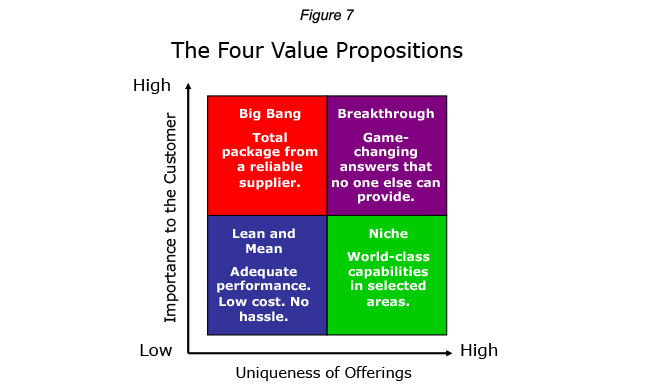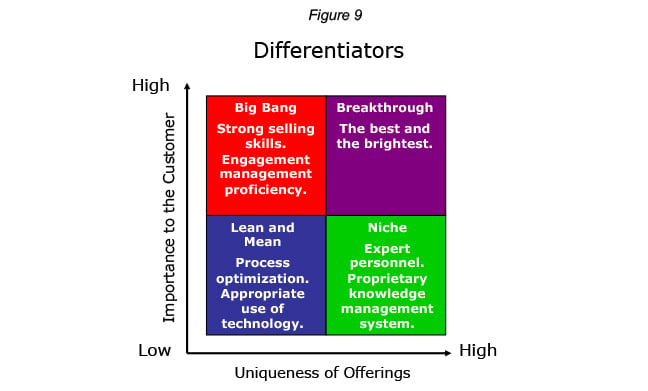No matter how talented your organization is, if you don’t have the right strategy, you’ll always suffer spotty customer satisfaction, fight problems with morale, and have to live with sub-par performance. My earlier article discussed:
- The four types of suppliers.
- The four value potentials.
- The customer expectations of each supplier type.
- The four types of buyers.
- The four buying strategies.
This article will articulate what to do for each of the four scenarios.
The Four Scenarios
We have seen how customers view suppliers. We know that they think and act quite differently in addressing each type of provider. The smart supplier executive realizes that the most successful strategy is the one that best aligns with how the marketplace sees you. There is a corresponding strategy that is appropriate for each of the four types of services providers. Starting from the customer perspectives in my last article, each strategy has distinct plusses and minuses, yet one and only one strategy is appropriate. Trying to be all things to all people leads to confusion, poor performance, and gross inefficiencies.
It is important to note that any of these strategies, appropriately implemented, can lead to prosperity, even greatness. The organizations that will be the most successful will be the ones that most effectively align their strategy with issues, wants, needs, and expectations of customers addressing their particular type (see Figure 6).

The Lean and Mean strategy is appropriate for Vendors. No matter what your capabilities are, how superior your services are over the competition, or what your promotional literature says, if the customer pegs you as a Vendor, you better act like a Vendor if you wish to survive. Therefore, since customers see your offerings as generic, you might as well accept it as a fact and do the specific things necessary for implementing this particular strategy. Examples of businesses following the Lean and Mean strategy include Acer and Emerson.
The Niche strategy is appropriate when you are seen by your customers as a Specialist—a mile deep in your particular expertise. The flip side is that they don’t see you as playing in other areas and will discount you if you try to expand beyond your expert core. Because businesses employing a Niche strategy are highly specialized and are often smaller firms, there is a good chance you may not have heard of them outside of your industry. For example, Datatel targets its IT professional services solely on the higher education marketplace, and 3-D printing company EOS focuses on just two types of additive manufacturing.
The Big Bang strategy is appropriate for the Total Solutions Provider, when an organization’s offerings are basically generic in the customer’s eyes, yet the offerings are important to the buying organization due to the overall cost or potential impact. This is the realm of the very big players, such as IBM and GE.
Finally, a Breakthrough strategy is appropriate for Game Changers, when your organization’s offerings are very unique and address the mission-critical issues of customers. Here customers will gladly treat you as a partner, as you have something very important that they want. Good examples here would be Amazon and SpaceX.
1. Value Proposition
The value proposition is your benefit communication vehicle. It is what you need to be known for to be successful (see Figure 7).

Suppliers following a Lean and Mean strategy know they are in the commodities business. Customers are always putting pressure on price, so to make money, companies pursuing a Lean and Mean strategy must be the low-cost provider. The low-cost leader can do well in this category, the second best in cost can eke out a living, while all others are doomed to a slow (and probably painful) death.
The value proposition of the Niche services provider is one built upon world-class capabilities in a narrow specialty. Because the issues are often complex and involve many players, the appropriate value proposition for a Total Solutions Provider trying to implement a Big Bang strategy is one that provides a total hassle-free package. The appropriate value proposition of the Breakthrough strategy must be dramatic and attempt to change the game through capabilities that only this organization possesses.
2. Drivers
Drivers are the “Type A” personalities of the business realm (see Figure 8).

Efficiency is the mantra of Vendors, as they always are looking to do things easier, faster, cheaper. Their internal philosophy is something like this: Don’t make a personal visit if a telephone conversation will do. Don’t touch the phone if e-mail can handle things. Don’t touch the keypad if the customer can use the Web.
To maintain your leadership position, a constant driver of the Niche strategy must be to continue to deepen your already vast knowledge and expertise of your selected specialty. Continually expanding the breadth of offerings by building, buying, or partnering is the heartbeat of the Big Bang strategy. The driver of the Breakthrough strategy must be innovation, as your people must constantly be on the edge, driving the new and dramatically better.
3. Differentiators
Differentiators are the core competencies most appropriate for supporting your strategy (see Figure 9).

A differentiator for a Lean and Mean strategy must support efforts to be the low-cost provider. Two of the most effective options are (1) being very good at streamlining and optimizing core processes, and (2) adopting the appropriate technology to automate and simplify processes and tasks.
The differentiators for the Niche strategy start with the highly specialized expertise of personnel, coupled with a strong, proprietary knowledge management system that captures and distributes the critical information that makes you different from your competitors—you are the keeper of the benchmarks and practices for your industry.
To pull the Big Bang strategy off, high-level selling skills (often internally called senior executive client development capabilities) are a must. Furthermore, strong engagement management capabilities that set and manage customer and partner expectations and deliver results on time, up to quality, and within budget are absolutes to making money.
As a Game Changer, your differentiator in achieving a breakthrough strategy is the extraordinary talent and skills of your “A player” professionals.
4. Critical Metrics
Critical metrics is how we keep score at the end of the day (see Figure 10).

Three of the main metrics that Lean and Mean organizations should track are the cost of sale, cost of delivery, and customer acceptance. The concept of customer acceptance is a vital one to grasp, especially since it goes in the face of all the hoopla over customer satisfaction/customer loyalty of the last two decades. If you are implementing a Lean and Mean strategy, approaches that “under-promise and over-deliver” or “knock their socks off” are the kiss of death. Customers will gladly take additional services, but they won’t pay for them. The secret of customer acceptance is to clearly define exact expectations (what they will pay for) and deliver exactly that—no more, no less. Deliver less, and you have an unsatisfied customer. Deliver more, and you have wasted resources and made a customer wonder why you are so foolish as to give away services in a low-cost game.
When pursuing a Niche strategy, your market is limited, so a critical metric is market penetration of all potential customers. Furthermore, retention of key employees is a must, as they carry your intellectual capital between their ears.
The Big Bang strategy is implemented by a series of big projects. Hence, project profitability is a key indicator of success coupled with satisfied customer ratings.
Finally, the Breakthrough strategy is best measured by key client retention and your ability to manage the talent process: finding, recruiting, hiring, developing, and retaining star performers.
Conclusion
Customers classify all suppliers into one of four types, like it or not. To be successful, the supplier executive must adopt one, and only one, strategy that aligns with the customer’s viewpoint and is compatible with the overall business blueprint. However, it is possible to reinvent your business in the eyes of the marketplace. A long-range plan grounded in solid market intelligence, supported by building new capabilities, and backed by a powerful market message can re-brand your image and allow you to migrate into a new strategic quadrant most compatible with your long-range business goals.
Modified from S-Business: Reinventing the Services Organization. 2003. James A. Alexander and Mark Hordes. ISBN 1-590-79054-5. SelectBooks.



